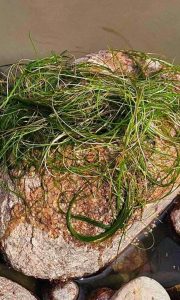
The residents with their own water bodies have found an aquatic plant resembling a ball of unwound green yarn. We asked Dr Zofija Sinkevičienė, Senior Researcher at the Laboratory of Flora and Geobotany of Nature Research Centre, to comment on what this plant is.
The sago pondweed (Stuckenia pectinata (L.) Börner)) is one of the world’s most widespread aquatic plant species. It grows in both fresh and salt water in every continent, except Antarctica. It can be found in both flowing and still waters: rivers, streams, canals, the margins of seas, lagoons, lakes, ponds and peat bogs. It is therefore not surprising if you find it in the waters of your immediate environment.
The sago pondweed has narrow, linear leaves and grows completely submerged underwater. It only brings its inflorescences to the surface during flowering. The flowers are pollinated by wind and the seeds float on the surface of the water and can be widely distributed. It reproduces not only by seeds, but also by starchy tubers that form on the rhizomes. The nutritious tubers are an important food source for water birds, as well as for aquatic animals, which contribute to the plant’s distribution.
Sago pondweed is tolerant of eutrophication, i.e. low water clarity and high nutrient concentrations, which can make it an uncomfortable weed in small artificial water bodies, navigable rivers and canals.
Text by: Zofija Sinkevičienė
